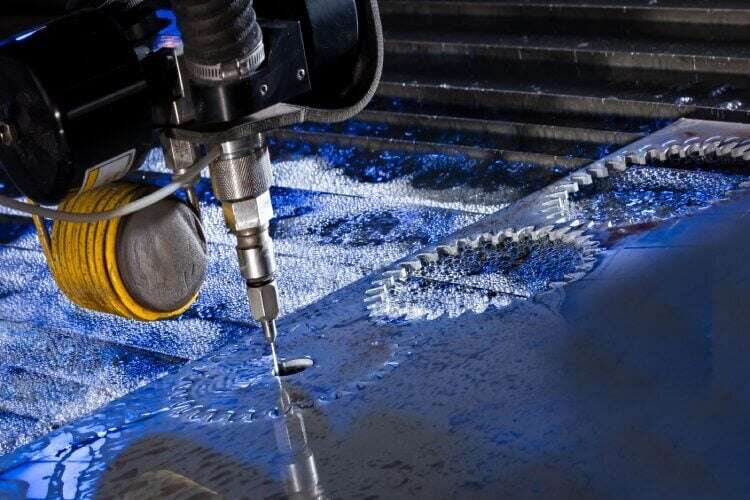You’re currently viewing the Americas website.
You’re currently viewing the Americas website.
Would you like to switch countries or language?Blast Abrasives
Topics
Waterjet Cutting
Topics
Resources
Categories
Types
Categories
Topics
Waterjet Cutting Tech Tips English Global
Benefits of Abrasive Waterjet Cutting vs. Laser Cutting
When selecting a cutting method for specific materials, various issues such as cutting speed, material thickness, cutting edge quality and industry standards of the parts to be processed must be considered. Strict tolerance requirements on high precision metal components manufacturing will always be a challenge to meet the global industry classification.
What is the main difference between Waterjet and Laser Cutting?
Abrasive Waterjet cutting differs from laser cutting in its specific cutting method. Instead of a laser beam, abrasive Waterjet systems are used to cut a wide range of materials such as stone, glass and metal. Abrasive Waterjet contains Garnet particles accelerated to one fifth of waterjet velocity to cut through hard materials.
Laser Cutting Systems use a gas-powered (CO2) laser to create energy. The CO2 gas is transmitted via a laser beam guided by mirrors mainly used for cutting metals.
What are the top 3 benefits of Waterjet Cutting vs. Laser Cutting?
1. No HAZ (heat affected zones)
For certain cutting processes HAZ are not allowed, especially in the aviation industry. Waterjet is considered as a cold cutting process, meaning that no heat is used in the cutting process.
2. No secondary finishing required
Waterjet provides an excellent cutting edge quality that is free of any sort of burnt edges. As a result, waterjet cuts are considered as a finish cut and does not require secondary finishing. Laser cutting require secondary finishing in most cases when you cut thick materials.
3. A wider range of materials
Waterjet systems are capable of cutting composites, stone, glass, metals, ceramics, plastic, rubber and many other materials.
Laser systems are mainly used for metal cutting. Cutting glass with a Laser system is a basically impossible task because of the fragile and reflective material properties.
 Heat affected zones and scum formation when cutting think materials with laser cutting.
Heat affected zones and scum formation when cutting think materials with laser cutting.
 Burnt edges from laser cutting.
Burnt edges from laser cutting.
Why aircraft manufacturers prefer cold cutting processes?
Hot process methods such as laser cutting can easily damage the primary material by overheating the structure and the integrity of alloys. The laser heats the surface of the material it touches by transferring the energy it carries to the material. Heat affected zones (HAZ) in metal can create micro cracks, deformation and oxide inclusions.
All those negative aspects are considered as flight critical in the aviation industry and therefore, Laser cutting is not considered as a preferable cutting method. Waterjet cutting is well known in the aviation industry to be the ideal cutting method that meets the highest quality requirements as it is inherently a cold cutting process.
How thick of metal can waterjet systems cut through?
When it comes to the maximum cutting thickness, waterjet beats laser cutting systems by a lot. Waterjet cutting systems are not limited in what they can cut, including material thicknesses. An abrasive waterjet system can cut up to any thickness, but tolerances can change the thicker the material being cut.
How to achieve high quality cutting edges with Waterjet?
With abrasive Waterjet you can achieve excellent cutting edge qualities at every stage of the cutting process. Besides the machine equipment and setting, it is equally important that you use the highest quality of garnet. The cutting edge qualities range from Q 1 to Q 5.
Q1 is the fastest cut, considered as separation cut and mainly used for material separation. Q5 shows the lowest cutting speed with the best possible cutting edge quality. While other cutting methods may potentially lose performance and edge quality from 2 inches / 5 cm onwards (for specific materials), waterjet can cut through titanium, Kevlar, and very thick stainless steel with ideal surface finish.
Does the Garnet quality really matter in abrasive waterjet cutting applications?
In abrasive waterjet applications water has the function to accelerate Garnet particles to the maximum possible velocity in order to create the energy necessary to cut a variety of hard materials such as stone, metal and glass. The accuracy and cutting edge quality in abrasive waterjet cutting applications are pretty much dependent on the Garnet quality. The better the Garnet grade and the higher the Garnet content the more you improve the cutting edge quality.
GMA Garnet™ is a uniquely strong natural mineral that effortlessly outperforms other abrasives. Due to its inherent strength in Hardness, Toughness and Density, GMA Garnet™ performs efficiently resulting in high productivity and precision edge quality.

 GMA ToughBlast™
GMA ToughBlast™ GMA SpeedBlast™
GMA SpeedBlast™ GMA NewSteel™
GMA NewSteel™ Oil & Gas
Oil & Gas Industrial Fabrication & Maintenance
Industrial Fabrication & Maintenance Marine & Ship Building
Marine & Ship Building TruCost Blast Calculator
TruCost Blast Calculator Product Selector
Product Selector Brochure | GMA Garnet Blast Abrasives
Brochure | GMA Garnet Blast Abrasives News: GMA's Roadmap to Sustainability
News: GMA's Roadmap to Sustainability GMA ExcelCut
GMA ExcelCut GMA ProCut™
GMA ProCut™ GMA ClassicCut™
GMA ClassicCut™ Metal fabrication
Metal fabrication Glass cutting
Glass cutting Stone cutting
Stone cutting Case Study | GMA ClassicCut | Smith and Nephew
Case Study | GMA ClassicCut | Smith and Nephew Why is Garnet the preferred abrasive in Waterjet cutting?
Why is Garnet the preferred abrasive in Waterjet cutting? Water Filtration
Water Filtration Rubber Fillers
Rubber Fillers Anti-skid Products
Anti-skid Products Ilmenite Sand
Ilmenite Sand Pyroxene
Pyroxene Rutile
Rutile